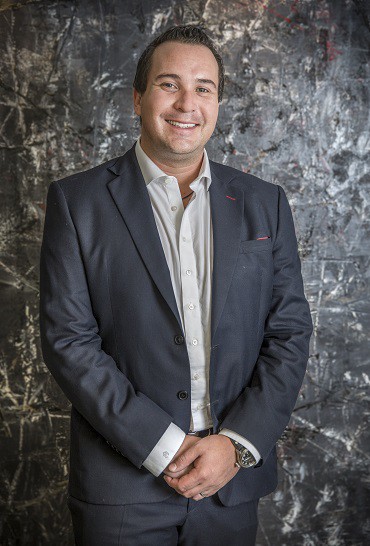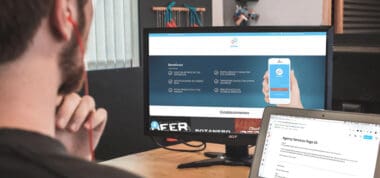Contxto – A few weeks ago, I spoke with my former colleague at Redwood Ventures, Ian Paul Otero. We spoke about Redwood’s history, best fundraising practices and what mistakes to avoid as an aspiring founder.
Our conversation reinforced the potential of venture capital in Mexico. Continue reading to learn more!
V: Who is Ian Paul Otero?
I: Let me begin by saying that to achieve your goals, all you need is the necessary capacity, at least in my opinion. Above all else, you need the tenacity and obstinacy to pursue them.
Back in the day, I was a lawyer and received my first opportunities in the public sector when I was 23 years old. I have always been interested in innovation, technology, and entrepreneurship, particularly in my role in the public sector.
During this time, I found a vocation and newfound understanding of micro companies and startups. After 12 years in different public sector positions, I decided to stop talking about entrepreneurship and start doing it myself.

Since 2008, I have been investigating what happened in the startup world. I asked myself: why wasn’t there any venture capital? How come angel investors weren’t organized? Can anybody tell me why were there so few institutional funds?
In 2015, my partner and I created Red Bean. Our goal was to support entrepreneurs and organizations in hopes of increasing profitability through technology and innovation. Around this time, accessing capital was really difficult for entrepreneurs to come by.
While there was a boom in 2012 with the development of 30 early-stage funds, there weren’t any in my home state of Jalisco. There was the Guadalajara Angel Investor Network (GAIN) but it was not created as an institutional VC fund.
To fill the void, my partners and I started building an investment thesis. It took us about nine months to feel comfortable with it and attract the profile of investors we wanted. In the end, Redwood Ventures emerged.
V. What can you share with us about Redwood?
I: From the very beginning, Redwood aligned itself to our investment goals, which continue to support technology-based projects among others. Specifically, we’re looking for projects that have already gained some traction with the possibility of scalability.
After a few years of overseeing various entrepreneurial projects, we knew, and still believe, that the ecosystem isn’t robust enough to focus on just a single sector. Therefore, we endorse various industries, but most interested in technology.

Some of the LPs and investors we invited to join gradually acquired more relevance in the industry, which was great for name recognition. Our investors are also quite diverse. One of them is a proper financial institution while others come from several sectors including the food, retail and pharmaceutical industries.
In the end, I believe that Redwood’s most valuable asset is the team, not only the operational team but also the investors.
V. What was it like starting a fund in Jalisco?
It has been really fun, a constant learning process with highs and lows.
We feel a deep responsibility to do it very well. Because if we do it very well, surely new funds and investors with venture capital will emerge.
And if we do it badly, maybe our mistakes will have the opposite effect than we expected.
V. What is Redwood’s status?
I: We have just formalized our fourth investment with Yotepresto. The other three companies in our portfolio include Billpocket, Ares Materials and Gurú de Viaje. I think with these four companies, we’re on the right track.
We have a lot of work cut out for us this year, though, especially in terms of expanding our portfolio. We probably have to invest in another four or five companies. However, the search process can be very exhaustive.
Entrepreneurs tell us how difficult and time consuming the fundraising process can be. I say “Well then, you have no idea what the process of investing is!”
Just to have four companies in our portfolio required screening over 367 candidates with similar hopes and aspirations. To say the least, it has been a learning experience but also very exhaustive.
V. What do you think of today’s ecosystem for Mexican entrepreneurs?
I: I see a growing ecosystem. It’s becoming an increasingly more sophisticated and professionalized ecosystem. I see many opportunities in sectors such as FinTech based on new regulations and laws that seem conducive to growth.
There needs to be more legal certainty for more VC investment. I think there is a tremendous opportunity in Mexico and Latin America due to such high rates of banking and lending programs. I also sense many emerging opportunities in virtual reality, biotechnology and the pharmaceutical industry.
The Secretary of the Treasury recently announced that Mexico will be lowering the tax rates for companies that go public. I believe that this is a strong message to industry players – a reassurance for the market and investors.
V. What’s the best way for an entrepreneur to approach Redwood?
I: The way to approach us is quite conventional and simple. Personally, I answer all emails sent to me. I always respond to requests via LinkedIn, as well. You never know when a new investment will come along.
There are no bad ideas or bad projects. There are only projects that do not fit our model and require different things than what we are looking for.
Ian Paul’s advise for entrepreneurs in a fundraising process:
1. Be clear about how much capital you need to reach your goal
From my perspective, overcapitalization is a common mistake among entrepreneurs. It may be tempting to exaggerate figures but that only creates problems.
2. Be careful with values
Sometimes entrepreneurs make the mistake of raising capital with very high caps and later they are the ones taking the hardest hit. When you want to raise more capital than you’re capable of, or when you have a history of flaws, then it’s highly likely that you will someday have to do a down round.
That is always terrible news for investors and entrepreneurs. To avoid this, I suggest using mechanisms and investment vehicles already available to you in Latin America, such as the tropicalized SAFE, or ABACO (in Mexico).
3. Be very transparent
We at Redwood think it’s important to be transparent. It’s even more important for transparency to be a soft skill for an entrepreneur. This is a certain responsibility that should always be applied to the business model.
I believe that when an investor-entrepreneur relationship is based on realistic expectations, trust and transparency – then both parties are more likely to succeed.
When we hide information, inflate numbers, invent potential customers, or forge letters of intent – that’s when things get complicated.
V. What is the number one error that every entrepreneur should avoid when pitching or negotiating with VCs?
I: I believe that the most unforgivable error is presenting things that aren’t strictly true. You have no idea how often we see this.
For me, it’s not even a matter of dishonesty. It’s more about an excessive desire for your business model to appeal to absolutely anyone, and that’s just not always possible. People do this just so they can get the capital investment they need, and for me, it’s disingenuine.
Many times the momentum overcomes us and we perceive opportunities that aren’t necessarily there or even realistic. If this happens, do not misinterpret it as a loss and lose optimism.
I like entrepreneurs with optimism in their business models, but for that reason, stay focused. Realism is a desirable trait.
I’ve had cases in which entrepreneurs tell me, “I’m so close to bringing the former CTO of so-and-so company on-board .” It seems like such an important endeavor that you expect it to be true.
Well, if this isn’t true, then you will be in serious trouble. If you do get away with the lie, you will inevitably have to find someone with those characteristics to fulfill that obligation.
I believe that this is a common error that generally leaves a bad impression, along with capital raising, exaggerated valuations, overcapitalizing, etc.
V. What kind of relationship does Redwood have with other Latin American countries?
I: That’s a very good question. To be honest, at least in the short term, we’re still in the process of collaborating with countries like Argentina, Colombia, Chile, Brazil and Peru.
Fortunately, though, our managing team is about to tour Argentina and Colombia with some accelerators and capital fund incubators. The goal is to observe the ecosystems in these countries and entertain the possibility of investing.
I also believe that we have a very important task in terms of integrating funds in Mexico. I think that the funds outside of Mexico City should make an effort to integrate more with major players. Some people don’t realize that there is capital available in the country’s interior and professional teams exist to make the administration process easier.
With Yotepresto, we already made our first co-investment with Variv, a fund from Mexico City. The truth is that this project succeeded because of our due diligence. It was a very good learning experience.
Now we need to replicate this kind of collaboration more often. I believe that the private capital industry is one of the few industries that can presume that other funds aren’t competitive rivals but complementary partners with the same mission.
V. What must an ecosystem do to become a global tech hub?
1. Promote innovation and high-impact entrepreneurship in the public sphere
Let’s start out by asking ourselves – how does society encourage more venture capital? For governments, maybe the most obvious thing to do is launch a subsidy or direct financing program. But what if that government doesn’t have the infrastructure or technical capacity to do so?
Maybe you realize that this is already the case for Mexico. Perhaps the most important buyer in any country, especially in Latin America, is the government. Why don’t we force ourselves to make innovative public purchases? First, we must see what our startups and SMEs (small and medium-sized enterprises) are doing.
We also have important legal incentives when it comes to income tax. Imagine how cool it would be if we credit a company’s income tax losses rather than unsuccessful investments?
2. Generation of incubators
Little by little, more successful incubation and acceleration processes are popping up in Latin America, even here in Mexico. That’s why I think it’s crucial to continue supporting incubators and accelerator programs like Reto Zapopan, 500 startups, Plug and Play and Hackers and Founders that will someday be very valuable.
Once another unicorn appears here in Mexico, then there will be more certainty and confidence towards private capital. From my point of view, that shouldn’t be our obsession. It will come eventually, and we must remember, Mexico’s ecosystem has different characteristics.
3. Creation of a new stock exchange
Fortunately, this is already happening and it’s very good news for the ecosystem. I was ecstatic when Mexico’s Secretary of Finance reduced the tax rate for companies going public. That’s a real incentive.
V. Do you have any book recommendations for aspiring founders or investors?
I: For founders, I recommend reading Bad Blood: Secrets and Lies in a Silicon Valley Startup. John Carreyrou, the writer, discusses everything an entrepreneur should avoid, like lying about products or services. In the process, he delves into examples of businesspeople far too obsessed with profitability in their business model.
Also, for those wanting to integrate themselves into the VC world or reap the benefits of capital investment, I would say read Startup Nation. It shows how nations prosper with a thriving entrepreneurial ecosystem.
-VC






